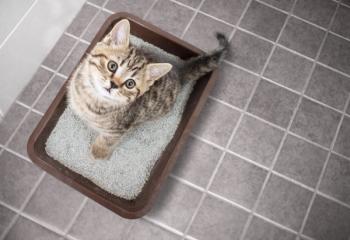
Working up pleural effusions in cats (Proceedings)
Cats presenting with pleural effusion are nearly always in respiratory distress, ranging from an increased respiratory rate and effort to open mouth breathing. In the latter situations, therapeutic intervention must be initiated quickly to prevent respiratory arrest. The therapeutic intervention also provides your first diagnostic test.
Cats presenting with pleural effusion are nearly always in respiratory distress, ranging from an increased respiratory rate and effort to open mouth breathing. In the latter situations, therapeutic intervention must be initiated quickly to prevent respiratory arrest. The therapeutic intervention also provides your first diagnostic test. However, the other 2 rule-outs for acute onset of severe respiratory distress is pulmonary edema secondary to cardiac failure and feline asthma. A rapid decision must be made to determine which therapy is most appropriate for the underlying cause.
Initial treatment
First, buy yourself some time, if possible, by placing the cat in an oxygen cage. Do not handle the cat until you have additional historical information from the owner (coughing, possible cat bite, weight loss, etc.) and you can observe the cat for clues as to the etiology. Radiographs are often not possible in a cat with severe respiratory distress so empiric therapy may be the only option you have to avoid exacerbating the situation.
Nature of the dyspnea
Inspiratory vs. expiratory
With lower airway disease, the patient is breathing in and out through inflamed, narrowed, reactive airways; thus, the air will need to be pushed out, producing a visible expiratory effort. This doesn't mean that the respiration rate is slow, simply that the effort is increased and the expiratory phase is prolonged. At the other end of the spectrum are lungs that are either compressed externally, i.e., by fluid or organs, or the airways are filled with fluids, e.g., heart failure. Pulling air into the lungs is impaired – restrictive pattern – therefore inspiratory effort is increased.
Auscultation
With pleural effusion, breath sounds will be absent or muffled in the dependent lung fields. You may be able to auscultate a distinct demarcation where the fluid begins. However, in long-standing effusive disorders, fibrosis causes pocketing of fluids and the demarcation may not as distinct. Thoracocentesis in these patients is also challenging and often requires the use of ultrasound.
Clinical signs
• Inspiratory dyspnea
• Tachypnea
• Open-mouthed breathing/cyanosis/preference for sternal recumbency
• Cough
Physical exam
On physical examination, you should begin to evaluate those systems that can contribute to pleural effusion, specifically the cardiac system. Arrhythmia, murmurs and pulses should be assessed and the jugular veins observed for distention. Ascites can suggest right-heart failure, for example, or be indicative of a hypoalbuminemic state. Fever should help you rank infectious diseases high, but don't forget that neoplasia and immune-mediated diseases also result in fever. A fundic exam is a must since FIP should be considered in cats with effusions of any kind. A thorough examination of the cat's body for evidence of penetrating wounds is necessary.
Thoracocentesis
Thoracocentesis is both therapeutic – potentially life-saving in severe cases – and diagnostic. Having a chest tap apparatus set up in your crash cart is prudent for these cases. You don't want to be assembling one as the patient goes into respiratory arrest.
Proper collection for the analysis guarantees you the maximum amount of information from the diagnostic test. You should obtain samples for a nucleated cell count (EDTA tube and 6-8 direct smears), biochemistry parameters, e.g., triglyceride (clot tube), and culture (aerobic/anaerobic culture media).
Fluid evaluation
Results of the fluid analysis guide the rest of your workup so it is important to obtain a sample of the fluid early on. While imaging can be helpful for some rule-outs, e.g., cardiac disease, the sample you obtained from the pleural space can rule-out a number of diseases without any imaging. In fact, if pleural effusion obscures important structures such as the heart and the mediastinum, the answer may lie in the fluid analysis.
Pure transudates (protein < 3 gm/dl and nucleated cell count < 1000/mcl)
The most common reason for a pure transudate is loss of oncotic pressure, i.e., hypoalbuminemia. Therefore, diseases that inhibit albumin production (liver) or can result in albumin loss (renal and GI) should be thoroughly investigated. Diagnostics should include: liver enzymes, pre- and post-bile acids, urinalysis with urine protein:creatinine ratio (UPC) if protein is present in a quiet sediment, fecal evaluation, abdominal ultrasound, GI panel (TLI, pLI, cobalamine, folate). Endoscopic exam of the upper GI tract or laparoscopic liver biopsy may be necessary to make a diagnosis.
Modified transudates (protein up to 3.5 gm/dl and nucleated cell count up to 5000/mcl)
Increased hydrostatic pressure in the vasculature or the lymphatics is the primary force producing a modified transudate. The most common cause is right-sided heart failure, which includes cardiomyopathies, valvular and pericardial diseases. Lymphatic obstruction can also produce a modified transudate, but neoplasia can be a cause of this as well. Diagnostics should include: echocardiography, central venous pressure to determine if there are elevated right heart pressures, ultrasound of the caudal vena cava, abdominal ultrasound to look for neoplasia elsewhere.
Non-septic exudates (protein > 3 gm/dl and nucleated cell count > 5000/mcl)
Inflammatory processes that can produce this diagnostic picture range from neoplasia to FIP. Neutrophils are non-degenerate and bacteria are not present. Cultures should be submitted nonetheless. Diagnostics should include: CBC, biochemistry panel, urinalysis, abdominal ultrasound (pancreatitis, e.g., can cause bicavitary effusions), fPLI. FIP continues to be a difficult diagnosis to make. A recent evaluation of ante-mortem diagnostics for confirming FIP drew the same conclusion: Anti-FCoV immunohistochemistry is confirmatory and if this is not available but suspicion of FIP is high due to clinical signs and other data, elevated serum alpha-globulin proteins may be helpful.
Septic exudates (protein > 3 gm/dl and nucleated cell count > 50,000/mcl)
The neutrophils are degenerate and intracellular bacteria may be observable. Cultures should be submitted, even if bacteria are not present. Chest wounds and migrating foreign bodies are 2 culprits. Recent evidence, however, suggests that a majority of cats with pyothorax do not have penetrating wounds. These pleural infections are due to para-pneumonic infections from oropharyngeal bacteria. In a case series of 27 cats the only historical similarity in 56% of the cases was a recent upper respiratory infection. Unlike dogs, cats with pyothorax can be successfully managed with closed thoracostomy tubes. Targeting bacteria that reside in the oronasal pharynx during therapy is ideal.
Hemorrhagic effusions (appearance of frank blood)
Trauma, rodenticide toxicity and neoplasia are the primary rule-outs to consider. Determine a PCV on the effusion and compare it to the peripheral sample. A cat with active bleeding will have a similar PCV in the effusion as in the periphery. Most hemorrhagic effusions have a PCV of 10% or greater. Diagnostics to consider include: clotting profile (prothrombin time [PT] and activated partial thromboplastin time [APTT]), other imaging to evaluate for trauma, lung torsion, diaphragmatic hernia and to search for neoplasia.
Chylous effusions (milky white or blood-tinged)
Not all milky effusions are chylous and not all chylous effusions are milky. The predominant cell type is the lymphocyte, the primary cell found within the lymphatics. In addition to the usual fluid analysis, triglyceride and cholesterol levels should be run on the effusion and compared with levels in the serum. Triglycerides are higher in serum unless an animal has been anorexic. Although trauma with rupture of the thoracic duct was attributed to most causes of chylothorax in the past, trauma is now thought to be a rare cause. The major categories outside of trauma include diseases that result in a high central venous pressure and idiopathic. Therefore, a thorough workup up of the cardiovascular system is imperative. As with modified transudates, cardiomyopathies, pericardial abnormalities and vena cava obstruction should be carefully explored. Mediastinal lymphoma that puts pressure on the vena cava is one example of a disease causing chylous effusion in some cats. Chylothorax has also been reported in cats with heartworm disease. Because of low worm burdens and all-male infections, both heartworm antigen and antibody should be tested. Echocardiography is also useful with 100% sensitivity for worm detection in some studies.
Neoplastic effusions
This category is not defined by a protein or cell count, but the presence – or suspected presence – of neoplastic cells. As previously mentioned, mediastinal lymphoma is one type of lymphoma causing pleural effusion. Multiple thoracocenteses may help reduce the amount of fluid enough to clearly view the thoracic structures on plain radiographs. Echo/ultrasound identifies cardiac masses, pericardial masses and other lesions if fluid surrounded, thus echo may be prudent to pursue prior to thoracocentesis if the cat is stable enough.
Other diagnostics
CT imaging is becoming more available and less cost prohibitive and is an invaluable tool for thoracic imaging especially in cases of pleural effusion. Thoracic exploratories are also less invasive with the use of thorasocopic procedures.
References
Barrs VR, Allen GS, Martin P, et al. Feline pyothorax: a retrospective study of 27 cases in Australia. J Fel Med Surg 2005;7: 211-222.
Fossum TW. Chylothorax in cats: is there a role for surgery? J Fel Med Surg 2001;3:73-79.
Dempsey SM, Ewing PJ. A review of the pathophysiology, classification, and analysis of canine and feline cavitary effusions. J Am Anim Hosp Assoc 2011;47(1):1-11.
Lee ACY, Atkins CE. Understanding feline heartworm infection: disease, diagnosis, and treatment. Top Companion Anim Med 2010;25(4):224-30.
Giori L, Giordano A, Giudice C, et al. Performances of different diagnostic tests for feline infectious peritonitis in challenging clinical cases. J Small Anim Pract 2011;52(3):152-7.
Newsletter
From exam room tips to practice management insights, get trusted veterinary news delivered straight to your inbox—subscribe to dvm360.






